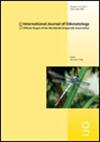Assessment of the water quality and Odonata assemblages in three waterbodies in Ilara-Mokin, south-western Nigeria
IF 1
4区 农林科学
Q3 ENTOMOLOGY
引用次数: 7
Abstract
This study investigated the biological water quality and Odonata assemblages in three waterbodies in Ilara-Mokin, with the aim of determining the ecological integrity of the ecosystems. Sampling of Odonata specimens was carried out over April–August, 2017 between 9.00am and 4.00pm under favourable conditions. Some physico-chemical parameters of the water such as dissolved oxygen, electrical conductivity, temperature, flow rate, pH, and water depth were also investigated. A total of 41 odonate species were recorded in this study and this was represented by 29 dragonfly and 12 damselfly species. These species are contained in seven families (Macromiidae, Gomphidae, Libellulidae, Calopterygidae, Coenagrionidae, Chlorocyphidae and Platycnemididae). The seven families were recorded at Aponmu River while Omifunfun River and Isokun River accounted for six and four families respectively. However, the highest number of individuals was collected at Isokun River. Libellulidae was the dominant family. Diversity indices revealed that Aponmu river was the richest in terms of species richness, diversity and taxa distribution (Shannon: 3.18, Simpson D: 0.95, Margalef: 7.38, evenness: 7.38, equitability: 0.93). Dragonfly Biotic Index (DBI) analysis indicated that Omifunfun River represented the best habitat condition in the study area while Isokun River was considered the most perturbed sampled site in the study area. Conservative efforts should be intensified to protect Omifunfun River in order to preserve all extant aquatic biota and other available resources therein.尼日利亚西南部Ilara Mokin三个水体的水质和蜻蜓群落评估
本研究调查了Ilara Mokin三个水体的生物水质和蜻蜓群落,旨在确定生态系统的生态完整性。2017年4月至8月,在有利的条件下,于上午9点至下午4点对蜻蜓标本进行了采样。还研究了水的一些物理化学参数,如溶解氧、电导率、温度、流速、pH和水深。本研究共记录了41种齿状物,其中29种为蜻蜓,12种为豆娘。这些物种分为七个科(大蠊科、蛾科、小蠊科(Libellulidae)、鞘翅目昆虫科(Calopterigidae),鞘翅目动物科(Coenagriondae)、绿蝶科(Chlorocyphidae)和扁蝶科(Platycnemididae))。这7个家族记录在阿波木河,而大宫丰河和伊索昆河分别占6个和4个家族。然而,在Isokun河采集的个体数量最多。Libellulidae是优势科。多样性指数显示,阿波木河物种丰富度最高,多样性和分类群分布(Shannon:3.18,Simpson D:0.95,Margalef:7.38,均匀度:7.38,等位性:0.93)。蜻蜓生物指数(DBI)分析表明,奥米丰河代表了研究区最佳的栖息地条件,而Isokun河被认为是研究区最受干扰的采样点。应加强保护奥米丰河的保守努力,以保护其中所有现存的水生生物群和其他可用资源。
本文章由计算机程序翻译,如有差异,请以英文原文为准。
求助全文
约1分钟内获得全文
求助全文
来源期刊

International Journal of Odonatology
ENTOMOLOGY-
CiteScore
2.30
自引率
0.00%
发文量
15
审稿时长
>12 weeks
期刊介绍:
International Journal of Odonatology (IJO) is aimed at providing a publication outlet for the growing number of students of Odonata. It will address subjects such as the ecology, ethology, physiology, genetics, taxonomy, phylogeny and geographic distribution of species. Reviews will be by invitation, but authors who plan to write a review on a subject of interest to the journal are encouraged to contact the editor.
 求助内容:
求助内容: 应助结果提醒方式:
应助结果提醒方式:


